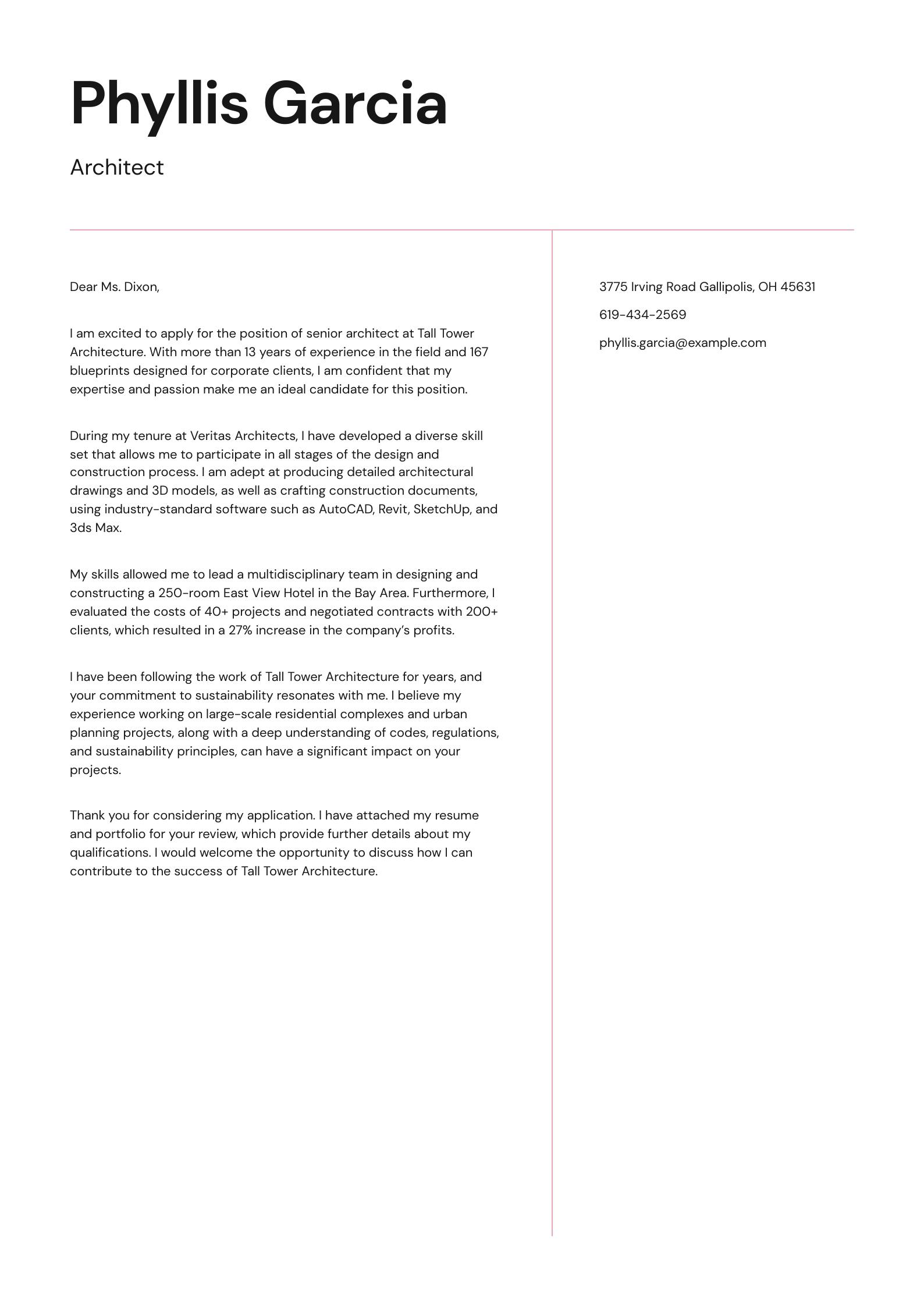
How to Write an Effective Application Letter [with Example & Tips]

By Sheila Kravitz in Cover Letters
An application letter is a vital document in any job seeker’s arsenal, at the same level of importance as resumes and cover letters. It’s often an applicant’s first point of contact with recruiters and hiring managers .
So, how do you write an effective job application letter to highlight your skills and experience, capture the potential employer’s attention, and increase your chances of getting a job? These are the questions that we’re going to answer in this article while also giving you concrete examples and expert tips that’ll make your letter shine.
Without further ado, let’s jump right in!
Key Takeaways
An application letter is a document similar to a cover letter or a resume that job seekers submit when they are interested in a role .
The document is similar to a cover letter example , and it should follow business letter formatting .
Before writing an application letter, you should research the company and read the job ad to find out which skills and qualifications are needed.
An introductory paragraph should be attention-grabbing , highlighting the amount of work experience you have and at least one highly impressive accomplishment.
The middle portion of the document should be all about your skills and achievements relevant to the job.
A call to action toward the end of the letter increases your chances of being invited for an interview.
What is a Job Application Letter?

A job application letter is a document that’s in many ways similar to a cover letter. It’s written and sent with the purpose of applying for a job . As such, it should convey valuable information about your skills, experience, and motivation for the role that you’re applying for.
However, while a cover letter is a supplementary document to a resume , a job application letter is typically a standalone document and should be sent without additional attachments. As a result, it needs to be longer and more detailed than a cover letter.
Still, an application letter should be a concise, one-page document that serves as an elevator pitch. Use it to get in touch with potential employers and make a lasting first impression that can secure you an interview and expedite the hiring process.
The Best Way to Format Your Job Application Letter
The best way to format your job application letter is to follow the business letter format and layout . This includes organizing the information in a specific way and ensuring that your document is visually clean.
Here’s how to arrange the information in your application letter:
Job Application Letter Format
Contact information
A formal salutation
A catchy introductory paragraph
The middle portion, with your skills and achievements
A closing paragraph with a call to action
A cordial letter closing with your sign-off
This is the optimal structure to follow when writing a job application letter, as it gives hiring managers the chance to see what they want to see exactly when they want to.
Now let’s see how you can create an impeccable layout for your application letter:
Job Application Letter Layout Guidelines
Your document should be one page long .
Choose an appropriate font for your application letter, like Calibri or Helvetica.
Set the font size between 10 and 12 pt.
Adjust margins to at least 1 inch on all sides.
Use 1.0 or 1.15 line spacing and insert an additional line between paragraphs.
Align text to the left or use justified alignment.
A Step-by-Step Guide to Writing a Perfect Application Letter

Let’s learn how to write an application letter for a job with a step-by-step guide that’ll show you how to craft every part of it.
#1. Research the Company
Researching the company is the first step before you even start writing your application letter . This is crucial, as your document has the best chance of garnering attention from hiring managers if it’s tailored and relevant to the position that you’re applying for.
That’s because every job is different, and even similar roles within the same industry require different sets of skills and experiences. By looking into the organization that you want to join, examining the job ad, and paying attention to the requirements, you’ll be able to pinpoint exactly what hiring managers and employers look for in candidates .
After that, you’ll be able to lean on those experiences, as well as the hard and soft skills that you know are necessary for the job. That’ll set you apart from other candidates with generic application letters that don’t entirely match the posted requirements.
#2. Write an Introduction
Writing a strong introductory paragraph is one of the most important steps in the process of crafting an application letter. It’s your way of grabbing the reader’s attention and persuading them to check out the rest of your document.
Hiring managers are busy professionals and sometimes merely skim through application letters , spending just a couple of seconds on each. That’s why you want the first few sentences to be as captivating as possible.
Use this paragraph to mention the position that you’re applying for, emphasize how much experience you have , and highlight one or two particularly notable accomplishments.
Here’s an example:
Introduction Example
I am writing to express my interest in the architect position at Sky Vision Inc., as advertised on your website. With more than 11 years of experience in residential design and project management, as well as a Global Award for Sustainable Architecture under my belt, I am confident that I’ll be able to contribute to your esteemed organization and lead your large-scale projects.
#3. Emphasize Your Skills & Achievements
Once you have the hiring manager’s attention, it’s time to impress them with your unique skills and achievements . Remember that the goal is to be as relevant as possible, so focus on those accomplishments that indicate how you are going to perform in their company should they hire you.
One of the best ways to make this part of your application letter pop is to use numbers for quantification . They add measurable value to your accomplishments, adding credibility to them and making them stand out in the eyes of hiring managers.
Let’s see that in an example:
Emphasize Skills & Achievements Example
I have a proven track record of handling more than 50 projects from inception to completion, within budget, and with no missed deadlines. One of my biggest accomplishments was carrying out a $35 million project and achieving a delivery time 13% faster than the industry standard.

#4. Say Why You’re a Good Fit for the Role
In addition to accentuating your skills and experience, you should stress that you’re the perfect person for the role you’re applying for. This builds on the summary of qualifications that you already talked about to show potential employers how they are going to benefit from hiring you .
To achieve this goal, you can point out the moments when your previous employers prospered from your work , such as how you helped them gain new clients, boost their revenue, improve their business, and more.
Why You’re a Good Fit for the Role Example
Exceptional skills in design software like AutoCAD and Revit, coupled with a commitment to green and user-centric architecture, garnered me a 96% user satisfaction rate and an increase in the company’s repeat business by 67%.
#5. Close Your Letter With a CTA
You should take the opportunity to include a call to action (CTA) toward the end of your application letter. A CTA is a marketing term describing something created to elicit a response .
In terms of an application letter, a CTA can be an invitation for hiring managers to contact you for a job interview . This one simple sentence can vastly improve your chances and secure you the next step in the hiring process.
Close the Letter With CTA Example
Thank you for your time. I would love the opportunity to discuss my qualifications over an interview and explain further how I could contribute to your organization.
Let’s put what we’ve learned into practice and check out a complete application letter example :
Application Letter Example

3 Tips for Crafting an Effective Job Application Letter
Let’s wrap it up with a couple of expert tips that’ll help you craft the best application letter for a job vacancy:
Job Application Letter Writing Tips
Show that you’re interested in the company. Mention something specific about the organization that you want to join that compelled you to apply to them in particular. That’ll set you apart from the competition, as it shows true passion and indicates that you’re already familiar with their work.
Address the reader by their name. Greeting the reader by their name creates a connection right from the get-go. It’s a great way to build rapport and show that you went the extra mile to research the company.
Write a new job application letter for every position. Don’t submit the same application letter every time you apply for a new job. Even slight modifications can still make your document look generic. For maximum chances with recruiters, your best bet is to write a new one every time.
Final Thoughts
Writing a strong application letter is a skill in and of itself. It represents a combination of research skills, communication skills , writing skills , attention to detail, and more. However, learning this ability is crucial, as it opens doors to invaluable opportunities and helps you move your career in the right direction.
Fortunately, learning to write this document is not that difficult once you understand the basics . The format and layout remain the same, regardless of the career or role that you’re applying for. One application letter sample works for any position; you just need to adapt it to suit your needs.
That’s why we’ve provided step-by-step instructions and a complete example of an application letter, arming you with all the knowledge you need. Best of luck getting the job of your dreams!
Application Letter FAQ
#1. when do you need a job application letter.
You need a job application letter when you’re applying for a role , and you want to stand out among the competition. This document serves as a testament to your skills and experience, and its goal is to portray you as a qualified candidate who’s perfect for the job.
#2. Is a letter of application the same as a cover letter?
A letter of application is not the same as a cover letter , but they share many similarities. The two documents have the same formatting, and both convey valuable information about your competence. However, a cover letter supplements your resume, while an application letter is a standalone and more comprehensive document.
#3. How do I write an application letter that stands out?
To write an application letter that stands out, focus on the skills and accomplishments that are relevant to the job that you’re applying for . Use an attention-grabbing introductory paragraph and include a call to action toward the end. Finally, leverage numbers to add measurable value to your achievements.

Create your cover letter once, use it everywhere
